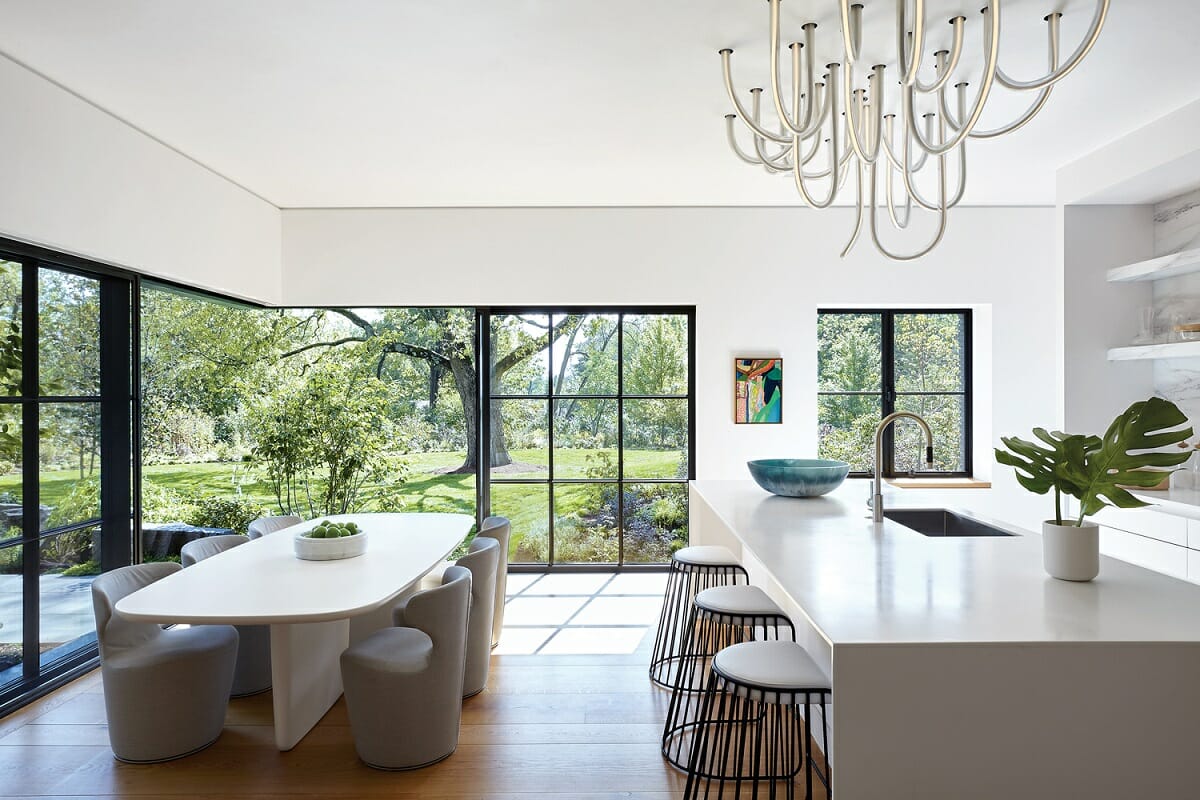Designing a kitchen is an ever-changing learning process, simply because how we use our kitchens changes all the time. Where once just one member of the home cooked, kitchens are now family rooms utilised for cooking, entertaining, dining, working, and even lounging.
So, meticulously designing a kitchen from the start is essential – and we’ve enlisted the help of prominent kitchen designers to define the process. We walk you through the design process step by step so that you may take all of your creative kitchen ideas and marry them with practicalities to create a flawlessly balanced area with inspiration from the world’s top kitchen designers.
The Basic Elements of Kitchen Design
Experienced pros should design your kitchen, but only in collaboration with you. This is due to the fact that how you utilise your kitchen will have a significant impact on the design decisions you choose.
Our step-by-step will show you how to design a kitchen like an expert, but you should always ask yourself if each stage is exactly what you want from the end room in terms of layout and functionality.
-
Create a Wishlist
Begin by brainstorming and penning down all of the aspects of your ideal kitchen.
This is the area for big-picture thinking. Which design trend have you been dying to try? What are your favourite appliances or luxury items? Make a list of everything you’ve ever desired. You should also consider what isn’t working in your existing setup.
You can put more intangible concepts on this list that your designer can assist you with, such as mixed-material cabinetry and varied countertop treatments.
Fine-tune your Wishlist by looking for interior design inspiration on websites and social media platforms like Pinterest and Instagram. Magazines and brochures are also great resources for staying up to date on the current kitchen trends.
-
Set a budget
Kitchen costs must be explicitly stated at the beginning of your project.
Your budget will determine how far you can go with your Wishlist. You must determine how much money you can realistically spend on the project. Include allowances for plumbing, wiring, lighting, appliances, flooring, decoration, labour, and any finishing design elements in addition to the kitchen itself. You should also budget 10% extra for any unforeseen expenses.
-
Plan how you will use the space
Designing a kitchen is more than just figuring out a layout that works with the available space; kitchen planning must also take into account how you intend to use the area.
First, consider how you want to use the area and your requirements.
Because today’s kitchens serve as the centre core of the home, we approach design by thinking about the layout in terms of moments, with areas to cook, dine, entertain, and occasionally sit and work. Even in a large space, try to keep the prep, cook, and wash sections as near together as possible to maximise efficiency.
-
Consider the perfect layout
Time spent in the kitchen can be made more joyful by effectively creating an ergonomic kitchen layout and maximising space. Try to arrange your sink, refrigerator, stove, and oven so that they are all within easy reach of one another, and then think about what storage to put in this area.
Cabinets and pull-out drawers near the oven are typically best suited for cooking oils, pots and pans, and dishes, whereas space near the sink is best suited for dishes.
Consider natural light and thoroughfares when arranging your layout – seating places should be near windows, for example, and the major cooking zone should not be the main thoroughfare between the hallway and the garden through the kitchen.
-
Choose the right cabinets
Consider how you want your kitchen to appear and feel as a starting point. Consider how it might link not only to the living and dining areas, especially if it is part of an open plan space, but also to your overall house plan.
Gather photographs of inspiring kitchens and begin to develop your ideas, considering how they might fit your space, the joinery elsewhere in the house, and the period of your property.
Painted kitchens are particularly appealing due to their timeless appeal and the ease with which they may be repainted to provide a different look and feel.
Modern kitchen concepts are a more difficult fit.
Consider whether you will like a contemporary flush (flat-fronted) kitchen in the future. Given the amount of money invested, cabinetry is definitely the one element you don’t want to change, but you can always repaint the walls and replace the backsplash later if you want.
-
Think Colours
Because the kitchen is more of a busy and bustling heart of the home than a tranquil room, bright, warm, eye-catching wall colours might work nicely.
Smaller pops of bolder colours, on the other hand, offer depth and individuality to a neutral kitchen room. Using paint to add a splash of colour to a cabinet front, bar stool, or shelving unit is not only cost-effective, but also provides for an easy injection of a unique burst of personality.
Colour options abound in kitchens, from appliances and flooring to window treatments and cabinets. Begin by determining how much of a long-term commitment you are willing to make. Painting a wall that can be readily changed is one of the simplest and least expensive solutions.
-
Factor in Appliances
As we spend more time at home cooking and socialising, there is a larger investment in kitchen equipment ranging from coffee machines to wine coolers that do not take up cabinet or other appliance space. All-in-one boiling water taps are now often replacing the standard mixer.
While ‘standard’ built-in ovens, refrigerators, and dishwashers are 60cm wide, wider appliances such as 76cm-wide ovens, 90cm-wide fridge-freezers (wider if you plan to create a cooling wall with side-by-side refrigerator, freezer, and wine cabinet) and range cookers up to 1.5m wide may need to be considered when designing a kitchen.
-
Work out Kitchen Storage
To get the most out of your kitchen, consider the number and type of storage you require from the beginning of the project. After all, this is the room in the house where you will most likely spend the majority of your time, so being able to find what you need quickly and simply can make cooking more fun.
Consider your space to be separated into zones for distinct functions, with sufficient storage for each zone and a simple sense of flow around the room.
A pantry or larder cupboard is priceless for storing dried and tinned items in the manner in which you live.
A breakfast cupboard or coffee station is particularly beneficial because it may keep everything you need in one location, such as cups, coffee machines, and biscuits.
A drawer with integrated plugs for charging phones and tablets (no unsightly wires trailing on the worktop) and dedicated out-of-sight spaces for baskets or bins to sort recycling are two other small kitchen storage options to explore.





























